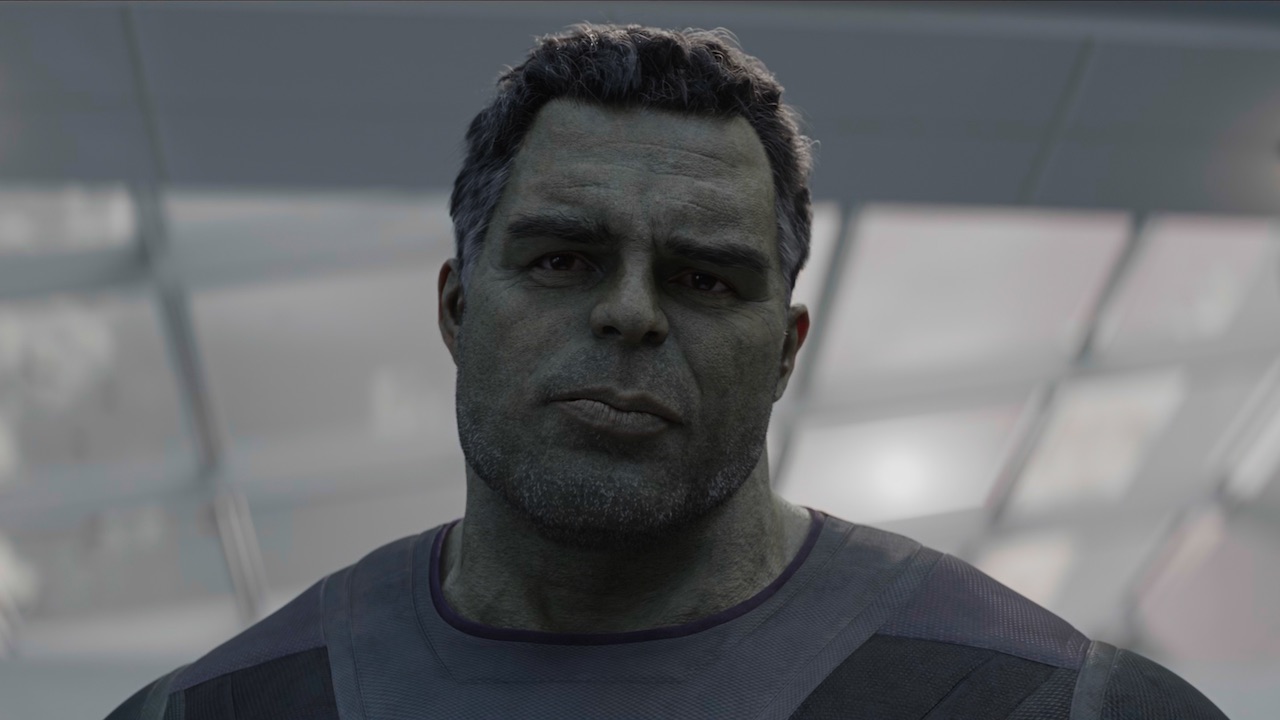Star Trek Into Darkness Behind The Scenes: The Geniuses Who Make It Happen

J.J. Abrams likes to play things close to the chest. Whether it’s the movies he’s directing or television shows he’s producing, as a filmmaker he’s a big advocate of the in theater surprise factor. He kept us guessing with Cloverfield, refused to reveal the monster in Super 8, and now has built a brick wall around Star Trek Into Darkness. But earlier this week Abrams and his crew dropped the drawbridge into his fortified castle.
As some of you may know, this past Sunday I was invited to a preview of the nine-minute prologue that will play in front of IMAX screenings of The Hobbit, and the next day drove out to Santa Monica to not only tour the headquarters of Bad Robot, Abrams’ production company, with a small group of other reporters, but also talk with the incredibly talented people behind the next Star Trek adventure.
Read on below to find out about the props and costumes, makeup effects, visual effects and music of Star Trek Into Darkness!
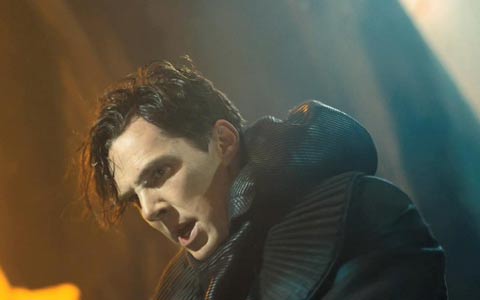
Looking The Part And Having The Right Equipment
Communicators. Tricorders. Klingon Bat'leths. Phasers. Insignias. These are just some of the many elements that immediately come to mind when thinking of the Star Trek universe and for that very reason the roles played by Andy Siegel, the prop master, and Ann Foley, the assistant costume designer, are some of the most important on the production of Star Trek Into Darkness.
As we began our tour through Bad Robot the first stop was to the prop and costume station, where they had display cases filled with many of the aforementioned gadgets as well as mannequins wearing some of the new uniforms that our favorite Star Fleet members will be wearing over the course of the new film. This included the blue robes worn when the Kirk (Chris Pine) and Bones (Karl Urban) are being chased by a huge tribe of aliens(as seen in the trailer), Spock’s (Zachary Quinto) volcano suit, a wetsuit worn by Uhura (Zoe Saldana), as well as more formal, grey ceremonial military garb.
But just like with any long running franchise, not everything can stay the same as it’s always been. While Star Trek Into Darkness will feature many of the classic pieces of tech that we know and love from the original movies and television series, they have changed to reflect the film’s higher budget and advancements in the technology of today.
Your Daily Blend of Entertainment News
“They already reinvented a lot of the stuff for the first movie, so you don’t want to go too far afield of that because they did a great job. The reinvention of the phaser was really terrific – we just tried to do what I would do if I had a second chance at anything. ‘Oh, what kind of refinements can you make?’ You get a new iPhone every year, you get a new tape recorder every year, so we kind of did that... With communicators I put the mesh back on because that’s sort of a nod to the old communicator.”
Even getting an update will be the insignia, which, according to Siegel, has been streamlined. A number of the designs were featured in a case next to the formal military uniforms. While they all maintained the classic boomerang look, we were told that each different one represents a different rank (so keep an eye out for that when you see the movie in May!)
As for new pieces of tech, one new element featured in the prologue is a very special briefcase-sized device that Spock takes with him down to the volcano planet in order to try and stop the eruption. Siegel said that this was actually one of the most difficult props to make simply because it had to somehow sell its function just through its appearance.
“The design started before I even came on [to the project],” he said. “It was a really different core streamlined idea and then J.J. really didn’t like it at all. He wanted something that was very practical and relatable. It’s a hard thing, because you’re saying what Spock has in this case that he’s cobbled together from stuff on the Enterprise is essentially going to freeze this entire volcano. Well, that’s in the script so you have to do it – it doesn’t matter that you have no idea how that works. So we had to find imagery that was like, ‘Okay, this is technologically advanced and Spock put this together.’ And then it has to break, and then you have to see Spock fix it in a way that you immediately relate to it and understand that, ‘Okay, this thing that he has is supposed to do something and now it’s broken and now he’s going to fix it.’ Which you tell me, did we do it?”
Unlike the first movie, which had a scene with Klingons that ended up on the editing room floor, Star Trek Into Darkness will have the famous alien species arriving in full force and that was something that props and costumes definitely had their work cut out for them on. Appearing much like how they did in the deleted scene from the first, the aliens wear masks that cover most of their faces – but have clearly defined ridges on the forehead area – as well as very organic armor that looks like it’s made from a thick hide rather than metal or other hard material. And when it came to the weaponry the idea was to make it has hardcore as possible.
“We tried to have an eye towards making it look as brutal as we possibly could,” Siegel said pointing at a case that contained a full size Bat'leth as well as other smaller pieces of weaponry. “It’s a very barbaric race and we thought Klingons, over the course of the series, go from scary to almost comical, and we thought, ‘Okay, these guys should be badass.’ We cast all real imposing guys and they are scary.”
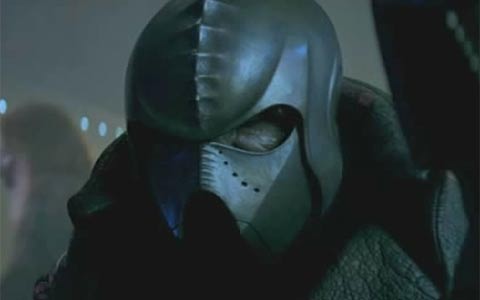
More Than Just Little Green Men
As cool as the Klingons look in their hard-shelled- armor and masks, they simply aren’t Klingons if they don’t actually look like aliens underneath. And because Abrams wanted his aliens to look amazing he hired David LeRoy Anderson.
A two-time Oscar winner (Men in Black, The Nutty Professor) and an artist on great titles such as The Cabin in the Woods, Zack Snyder’s Dawn of the Dead, and the Abrams-produced Mission: Impossible - Ghost Protocol, Anderson is a newcomer to the Star Trek franchise – but it didn’t take him long to discover the extreme challenges of the job. While he initially thought that most of his job would involve working in his makeup trailer and bringing designs to life, he found himself on-set a great dealing with one very specific, yet very important task: setting Spock’s classic Vulcan eyebrows.
“I was mutilating his face, and shaving his face,” Anderson said jokingly. “It made me nervous, it made him nervous, so I approached it very delicately.”
Because of their comfort level with each other he understood that he would have to be the one to apply Quinto’s makeup every day. The process involved plenty of careful shaving and plucking, but by far the most painstaking and time consuming part of the process was setting the fake hairs – of which there were many. All told the eyebrows took 45 minutes for each side, which I have to imagine would be an amazingly awkward thing to have to sit through every day for weeks on end.
And, of course, that kind of time commitment also has an effect on the other side of the job, the realization of the alien designs, which was all simultaneous to his work in applications.
“We’d have a four o’clock in the morning call, we’d be done with the makeup by 6:00am. I got on the road, an hour later I’m in Van Nuys in my studio – I work eight hours there. Get back in the car, get back [to set] and they’re still working because it’s 16 hour days – and I’d catch the last four or five hours on set. So my days were really long, sleep was really brief, but it was awesome.”
On the design side, Anderson also ran problems when working to figure out the best way to design Klingons in this new version of the Star Trek universe (though the new movie doesn’t ignore what can be seen in the deleted scenes from Abrams’ first movie). When trying to determine the Klingon look they realized that by using huge blocks of foam rubber on the actors’ faces they would end up making everyone look exactly the same, and they wanted each individual member of the species to look different. To fix this issue the makeup team worked to leave faces more exposed and used multiple pieces when applying makeup to allow for better facial movement.
“It’s a real balancing act,” Anderson talked about dealing with the fact that the Klingon look is so iconic. “You don’t want to stray too far, but you also don’t want to go back and cookie-cut the exact same thing. There have been a lot of advances and we have the opportunity to do a new, fresh pass without losing anything.
Beyond established alien races, the movie also allowed Anderson to flex his creative muscles a bit as well, coming up with all kinds of designs for new species. A number of alien busts were out on display, and we got to see multiple cool designs, including a strange one for Joseph Gatt (who has a metallic disc in the back of his head that has the exact same design as the ceiling of the bridge on the Enterprise), as well as an alien with a strange waddle around its neck that inflates and illuminates when the creature breaths (this particular one will be played by Heather Lagenkamp of Nightmare on Elm Street fame, who also happens to be Anderson’s wife).
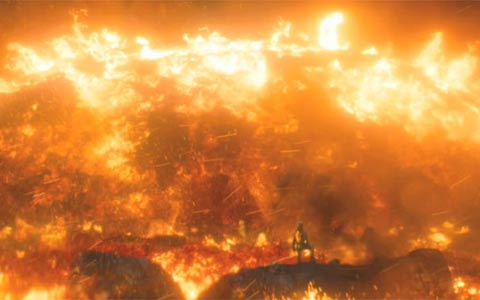
Designing The Future
At the beginning of the prologue the camera pans zooms towards a window, looking out at the city of London, year 2259.55. But obviously it’s not a real window to the future – it’s a manufactured digital image that’s designed to not only fit with the aesthetic of the future world that the director has designed for his version of Star Trek, but also one that’s immediately recognizable to the people who have a grasp on what London looks like today. That’s where Roger Guyett, the film’s Visual Effects Supervisor comes in.
“Sometimes we take center stage, like when we were making black holes in the last movie, or they’re doing a space jump, but other times we’re creating worlds around [the cast’s] performances and create this future world,” Guyett told us as he began his presentation, showing clips from the prologue as he talked.
Going into the design of future London, he explained that what goes into it is more than just keeping scattered landmarks and updating everything with a chrome finish and flying cars. Instead the design process incorporates the style and essence of a city as it is today and tries to estimate how it will actually look in the future. “We work very hard in trying to be respectful to the styling of the architecture of a city when you’re trying designing aspects to it,” Guyett said.
That said, the team behind the visual effects did keep parts of the skyline that are currently part of London, including the London Eye and St. Paul's Cathedral (where, funny enough, Guyett’s wife proposed to him).
But just like he said at the start, sometimes the visual effects are just in the background and sometimes they are the star of the show, and movie-goers who go to see the prologue will be treated to both. Following the scenes in London the footage travels far, far away from Earth where the crew of the Enterprise is working to stop an entire planet from being decimated by a giant volcano (which threatens to wipe out the entire surface population). The highlight of this part from an effects perspective is a scene where Spock is trapped on a small rock island surrounded by an ocean made of hot, bubbling lava.
To make the shots possible they constructed a small patch of rock for Quinto to stand on while the surrounding areas were layered and mapped with pools of magma. “The lava itself is just enormous computer simulation,” we learned. “It analyzes all sorts of funny things. It does stuff like temperature, and then the temperature controls the viscosity, and then the viscosity controls the motion, and the computer’s brains are about to explode trying to figure out all these minute little details.”
It’s a job that requires looking at absolutely every detail on the most microscopic scale, and only making that more of a challenge is the fact that Abrams has shot the film both in 3D and using IMAX cameras.
“It’s considerable,” Guyett said when asked how much more effort goes into a project in the dual formats. “It’s like anything like that. There’s more pixels on the screen, bigger format. Certainly everything that we did is true 3D, it’s not converted…it makes a difference.”
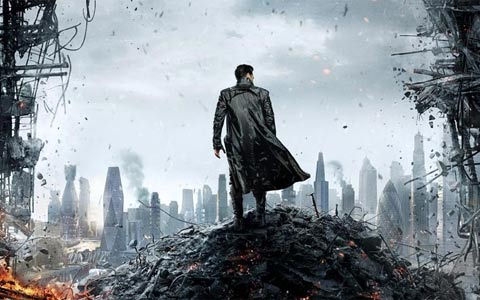
The Music Of The Final Frontier
Michael Giacchino is handedly one of the best composers making scores in Hollywood, and he and J.J. Abrams go way back. First working on Alias together, they paired for Lost, Fringe and other television shows, and Giacchino has done the music for all three of Abrams’ directorial efforts, including the first Star Trek. And of course he’s back for Star Trek Into Darkness.
Bringing us into his music studio, the composer played footage from the prologue where Sulu (John Cho) and Uhura (Zoe Saldana) have a serious discussion on a hovercraft about dropping Spock towards the volcanic surface of the planet below as well as a scene where Kirk (Chris Pine) and Bones (Karl Urban) are being chased by a strange alien tribe. The first time he showed the footage he did so without the music – just the dialogue and effects tracks – and then again with only the music. Even without hearing what the characters were saying the score perfectly communicated the stress of the situation.
“Music says what words can’t,” Giacchino said while introducing the footage. “So even though there’s dialogue, even though there’s things that the characters are saying, it’s about ‘what do I need to find that says what these guys aren’t saying.’”
Naturally this means that a big part of his job on the film is establishing each scene’s emotional core. During a chase scene you want something that’s going to make the audience tense while also demonstrating that the characters are running hard and are possibly scared. Comedic moments should have a lighter touch and create a sense of ease. Some might take issue with this idea, seeing it as a form of manipulation, but Giacchino sees no problem with that definition as that’s exactly what filmmaking is all about.
“Everything that J.J. wants you to feel and follow, I’m there to kind of yank you through,” he said. “And yes, you can call that manipulation. It is manipulation! Any film is manipulation, really… Anyone who says, ‘You were manipulating me!’ Well, no shit! Of course we were manipulating you, that’s why you go to the movies – to be manipulated.”
Sometimes it’s important to blend those emotions as well. After their leap off the cliff and swim to the Enterprise, Kirk and Bones get inside the ship and the water is drained. Giacchino makes the music a bit more celebratory in this moment, and keeps that going through a pop-up funny moment with Scotty (Simon Pegg). But part of the job is to remind the audience of the tense situation going on with Spock at the volcano and the score reflects that with underlying tones.
Much like his work on the Mission: Impossible movies, Giacchino’s work on Star Trek comes with an extra special challenge because the theme from the original series is so memorable (I’m sure at least half of you reading this could hum it at the drop of a hat). And that theme is certainly something that the composer wants to feature in his work.
“For me the one thing I would love to incorporate some way, somehow, is the Alexander Courage theme. To me that is Star Trek. How you use it is really up to the story and you really have to think long and hard about how you do it because if you do it in the wrong spot it feels wrong or feels cheesy. And in the instance of the last movie, we tried it in the body of the film, but it never really worked because, you know, the truth is that it wasn’t Star Trek until they were at the end of the film as a crew together on the bridge… with this film I have no idea yet.”
And with the release date all the way in May there’s still plenty of work to be done. All of the various post-production departments are still hard and work trying to get their pieces of the puzzle ready to be part of the larger picture, but rather than being an individual piece Giacchino’s score is more like the spray glue that you use once the puzzle is finished and you want to seal it up perfectly.
“Up to this point the only music I’ve written is what you’ve seen in this, so I don’t know what I’m going to do yet because I haven’t seen the whole film yet,” the composer said. “I don’t know what the rest of the film needs or asks for. I have to wait until I see it.”
And that waiting feeling is certainly relatable.
For more from Star Trek Into Darkness, be sure to head over to our Blend Film Database.

Eric Eisenberg is the Assistant Managing Editor at CinemaBlend. After graduating Boston University and earning a bachelor’s degree in journalism, he took a part-time job as a staff writer for CinemaBlend, and after six months was offered the opportunity to move to Los Angeles and take on a newly created West Coast Editor position. Over a decade later, he's continuing to advance his interests and expertise. In addition to conducting filmmaker interviews and contributing to the news and feature content of the site, Eric also oversees the Movie Reviews section, writes the the weekend box office report (published Sundays), and is the site's resident Stephen King expert. He has two King-related columns.
